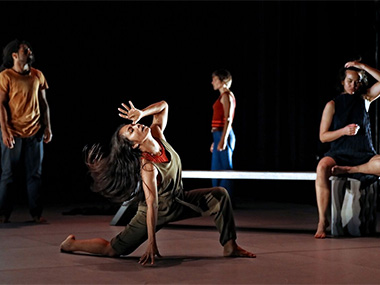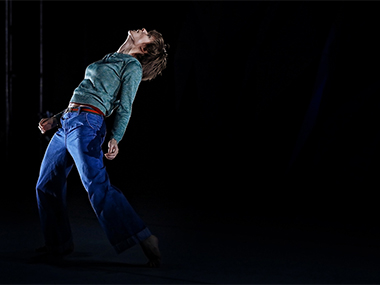SCHIZOPHRENIA OF THE COLONISED

The cast of Marrugeku's 'Le Denier Appel' in individual mode with that flashing screen
Posted by Jeremy Eccles | 17.08.18
Dates:
15.08.18
: 18.08.18
Location: Carriageworks, Eveleigh, Sydney
Dance is a wonderfully abstract medium which can allow for a myriad of interpretations. But, aided by the persuasive writing in the program for 'Le Denier Appel' (The Last Cry) at Carriageworks only until tomorrow, I read the impassioned and sensationally well remembered dancing by this mixed group of Aussies and Kanaky New Caledonians in an almost entirely political way.
For co-choreographers Serge Aime Coulibaly and the Yawuru/Bardi woman Dalisa Pigram from Broome clearly reference both the imminent referendum that may free New Caledonia from its French colonial shackles and the Uluru Statement from the Heart (and its rejection by the Government), and declare, “As artists and citizens, we meet in shared states of frustration, resigned tolerance and fatigue of telling and retelling truth to power”. Mind you, they go on to quote Samuel Beckett's refusal to define his immortal 'Waiting for Godot', though they draw from it “the possibility and challenge of living together for mutual benefit”, seeing the Uluru Statement's proposed Makarrata – coming together after struggle - as a potential road away from colonialism.
So, as the six dancers simply stare at the audience, and something I might call tribal pop music in an original score by Nick Wales and Bree van Reyk sounds, I'm sensing antagonism, diminished slightly by hand and mouth movements which may be attempts to explain the existential. It's a challengingly inactive beginning, backed by a small screen that refers passingly to massacres and apartheid. Nervous intensity abounds, released at last by Krilin Nguyen's hip-hop solo. Later, after the others have got up the strength to dance in their own styles, Nguyen will fall and fall athletically but emphatically to the ground.
Finally, individual's movements are brought together – but it's a long time coming; as though the eventual coordination of depressed and schizophrenic individuals is a hard-won but key stage of the struggle. They comfort each other – and occasionally fight – as the music rises to an exhilarating pitch. The screen now revolves, a reflected spotlight flashing furiously into the audience. Exhaustion sets in – independence, political or social, has not been given or taken. Shaking grief is seen as clothes are shed and a minimal piano sounds. Pigram slaps herself repeatedly, pointing a finger at her troubled head.
It's an extreme picture of the undoubted psychological stages still-colonised peoples go through. Though resilience rises again at the end – perhaps in reference to the possibilities inherent in both the Kanak referendum and the Uluru Statement.
The importance of the piece to Australia's Marrugeku company and New Caledonia's Centre Culturel Tjibaou (named after the assassinated Kanak leader) is reflected in the investment in time since 'Le Denier Appel's rehearsal period began 9 months ago. But after this all-too-brief world premier season it heads to New Caledonia, Melbourne and France. Will it be read politically or aesthetically as it travels? Either way, it's powerful stuff.
URL: http://carriageworks.com.au/events/le-dernier-appel-last-call/
Share this:
»  del.icio.us
»
del.icio.us
»  Digg it
»
Digg it
»  reddit
»
reddit
»  Google
»
Google
»  StumbleUpon
»
StumbleUpon
»  Technorati
»
Technorati
»  Facebook
Facebook
Contact Details

Choreographer and dancer, Dalisa Pigram (foreground) performing with (l to r) Stanley Nalo, Miranda Wheen and Amrita Hepi

Australian dancer Miranda Wheen at her most existential in 'Le Denier Appel' - all photos by Prudence Upton
Further Research
News Tags: Carriageworks | Centre Culturel Tjibaou | Jeremy Eccles | Kanaky referendum | Le Denier Appel | Marrugeku | Nick Wales | Uluru Statement
News Categories: Blog | Event | News | Other Event
Exhibition Archive
- 19.08.18 | CIAF Sets Records
- 16.08.18 | The Politics of Art in Darwin
- 01.08.18 | A SENSE OF PLACE
- 29.06.18 | INTERNATIONAL ACTIVITY
- 24.06.18 | Blak Markets Back in Sydney
- 22.06.18 | “I am the old and the new”
- 08.06.18 | WARS & MASSACRES
- 03.06.18 | NY “Goes Ballistic” over Aboriginal Art
- 24.05.18 | THE LOCKHART BRAND IS BUOYED UP
- 03.05.18 | THE WYNNE'S A WINNER AGAIN
- 02.05.18 | NATSIAA FINALISTS ANNOUNCED
- 07.04.18 | ENGLAND'S EMILY?
- 04.04.18 | THE SONGKEEPERS
- 19.03.18 | ON GADI COUNTRY
- 16.03.18 | SPECIAL REQUEST
Advertising

